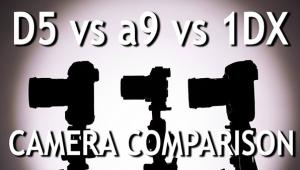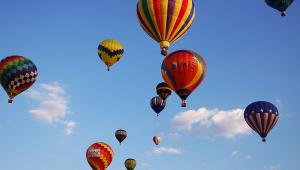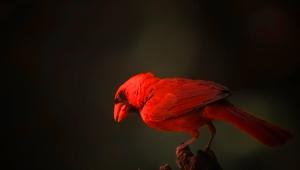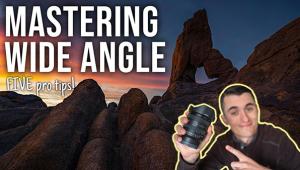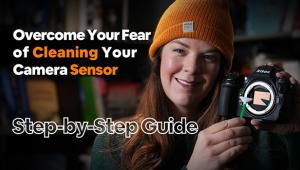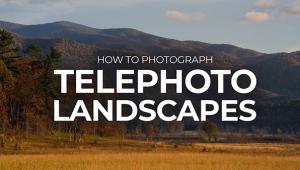Nikon’s D300s; The Move To SLR Video Keeps Going Page 2
I would like to extend that lack of fondness to the camera’s confusing menu structure that approaches the “kitchen sink” design so beloved of Olympus’ engineers and unloved by me. Regular Nikon shooters, like my friend Cliff, who have no trouble with the controls or menus will wonder why I keep harping on this so here’s why: new SLR shooters can be confused by these menus and while I know you can get used to anything (like driving a right-hand drive English car in America) that doesn’t mean it’s a good thing. When I received the camera the Exposure Delay custom function was set On. When I tripped the shutter the viewfinder went black (as the mirror locked up) and then the exposure was made. It took me a long time to figure out what was set and how to reset this custom function back to normal.
Like all recent Nikons, you can process Raw files and convert them into JPEG images in camera and you have to see this process in action to believe how easy it is to use. Unlike few other cameras, the D300S allows uncompressed TIFF capture as well, which should be a hit with studio shooters who need to hand clients image files without their needing any conversion right now. Nikon Raw (.NEF) files are compatible with the wonderful and optional ($149.95) Mac OS and Windows Capture NX2 photo-editing software. Adobe Camera Raw 5.5 supports the D300S’s .NEF files but ACDSee (www.acdsee.com) does not, although I’m guessing by the time you read this that will change.
 |
 |
|
 |
||
|
||
I tested the D300S with two lenses, including Nikon’s AF-S DX Nikkor 18-200mm f/3.5-5.6G ED VR II and Sigma’s (www.sigma-photo.com) 10-20mm f/3.5 EX DC HSM. Details on the Sigma zoom can be found in a sidebar but the 18-200mm Nikkor uses a number of Nikon technologies, including a Vibration Reduction II (VR) Image Stabilization system that provides camera shake compensation equivalent to four stops, a Silent Wave Motor (SWM), as well as a new zoom lock control that previous versions lacked. This feature became invaluable during studio shoots because when I walked from camera position to show the model some of the shots on that big 3” screen and returned to camera position the focal length had changed—a lot. Use the lock; it’s no biggie to unlock when you need to change focal length.
I wanted to test the in-studio capabilities of the D300S, but because my own is currently in phase three of reconstruction (see the October 2009 issue of Shutterbug) my colleague Jack Dean (www.jackdeanphotography.com) allowed me to do test shoots at his much larger facility. The camera has a real jumping up and down PC connection for studio lighting, although I guess by now everybody is using something like the PocketWizards (www.pocketwizard.com) we used. During the session I shot against a black background and a white, high key one, neither of which I’ve tried in a long, long time. Although contrastier than the normal “flat and boring” lighting style I prefer, I was pleased with the results and how well the D300S handled and focused under these conditions.
 |
|
|
Since I know that some of you might be interested, I tested the D300S’s infrared capability and was impressed by the results on several levels: first was the excellent response to IR filters and second was the way noise was controlled for the long (8-10 second) exposures that using the filters produced. The front of the AF-S DX Nikkor 18-200mm lens accepts 72mm filters (the Sigma requires 82mm filters) and for the digital IR examples appearing here, I used a Cokin 89B A-sized filter, holding it in front of the lens to minimize light pollution from the sides that would have occurred if it were mounted on a modular holder.
Because you’ll need to remove the lens hood to hold the Cokin filter there’s always the possibility of flare, reflections, and getting your fingers in the shot, but I experienced none of those problems. A 72mm Hoya RM-72 infrared filter costs $286.35 while a Series A Cokin 89B is $41.51, making it worth the hassle. In addition to the before and after shots on these pages, you can view a video clip on the Shutterbug website of the location where these IR shots were made.
The D300S is an impressive DX-format camera for any Nikon shooter who wants and needs video capture (are you listening wedding photographers?) along with really high-quality image capture. It’s neither cheap nor too expensive so even aspiring pros should be able to fit one into their budgets. And if that budget permits, add the AF-S DX Nikkor 18-200mm f/3.5-5.6G ED VR II lens to the package. Wedding shooters will find that its focal length, versatility, and image stabilization make a wonderful complement for both still and video capture.
Video D-SLR Accessories Sidebar
If you’re serious about shooting something other than the occasional YouTube file of Junior making his first steps to the delight of grandmas everywhere, you’re going to need some help to make those clips look better. Start by looking at the professional gear that Redrock Micro (www.redrockmicro.com) makes for SLRs that includes a shoulder mount and handgrips for steady handheld shots as well as a support cage for enhanced stability and low-angle shots. For cameras that lack video AF, their accessories permit follow focus with lens gearing for accurate and repeatable focusing and even offer a swing-away matte box (bellows-style lens hood for us still shooters) as well as easy access for changing lenses. Another alternative is iDC’s (www.idcphotography.com/kart) U-Boat Commander Rig that’s compatible with Nikon cameras and accepts an
ARCA-SWISS Quick Release clamp or Manfrotto QR.
 |
|
|
Sigma’s 10-20mm f/3.5 EX DC HSM Sidebar
I have no personal Nikon-mount lenses, so I borrowed this wide-angle zoom from Sigma. With its 102.4? angle of view it produces striking images that with the 1.5x multiplication factor translates into a 15-30mm equivalent angle of view. The design includes two ELD (Extraordinary Low Dispersion) glass elements and a SLD (Special Low Dispersion) element to produce excellent color aberration correction plus four aspherical elements to correct for distortion and allow compact and lightweight yet professional construction. The incorporation of a Hyper-Sonic Motor (HSM) ensures quiet and high-speed autofocus as well as full-time manual focusing capability down to a minimum (and amazing) focusing distance of 9.4” throughout the entire zoom range. While not cheap at $479, this is the perfect lens for shooters, like me, who love wide-angle lenses.
 |
 |
Technical Specifications
Approx. Dimensions: 5.8x4.5x2.9”
Approx. Weight: 32.6 oz
Cost: $1699.95 (body only)
| D300 Vs. D300S: What's The Difference? |
||
| Nikon D300 | Nikon D300s | |
| Sensor (Effective Resolution) | 12.3-megapixel CMOS | 12.3-megapixel CMOS |
| Sensor Size (mm) | 23.6mm x 15.8 | 23.6mm x 15.8 |
| Magnification Factor | 1.5x | 1.5x |
| Sensitivity Range | ISO 100 (expanded)/200 - ISO 3200/6400 (expanded) | ISO 100 (expanded)/200 - ISO 1600/3200 (expanded) |
| Continuous Shooting | 6 fps, n/a Raw/100 JPG | 7 fps, n/a Raw/100 JPG |
| Memory Cards | CompactFlash Card, (Type I and II, UDMA compliant), Microdrive | CompactFlash Card, (UDMA compliant), SD, SDHC compliant |
| Viewfinder | 100% coverage | 100% coverage |
| Effective Magnification | 0.94x/0.63x | 0.94x/0.63x |
| Autofocus | 51-point AF, 15 cross-type | 51-point AF, 15 cross-type |
| Live View | Yes | Yes |
| Video Capture | No | 720p at 24 fps |
| LCD Size | 3” fixed, 920,000 dots | 3” fixed, 920,000 dots |
| Shutter Durability | 150,000 cycles | 150,000 cycles |
| Battery Life (CIPA Rating) | 1000 shots | 950 shots |
| Dimensions | 5.8x4.5x2.9” | 5.8x4.5x2.9” |
| Body Operating Weight | 29.3 oz | 30 oz |
| Price (Body Only) | $1649.95 (currently) | $1699.95 |
For more information, contact Nikon Inc. at: www.nikonusa.com.
- Log in or register to post comments











